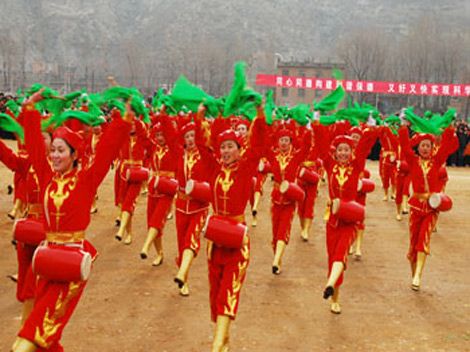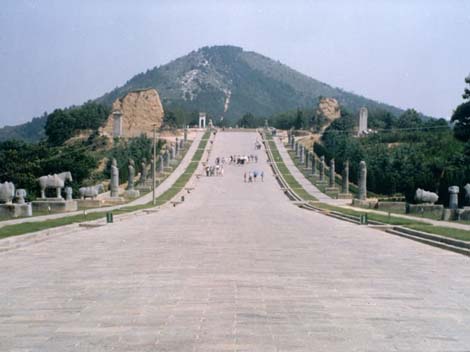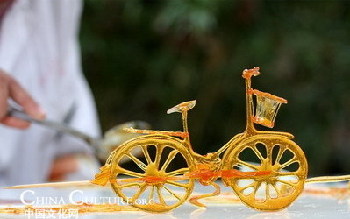| Home > China Feature |
Huang Chao Rebellion - Leading to the Downfall of Tang Dynasty
The reign of Emperor Xizong of Tang was struck by natural disasters, which led to famines, the effects of which were exacerbated by a heavy tax burden. In 874, the Wang Xianzhi rebellion broke out, followed in 875 by the infamous Huang Chao rebellion that would haunt Xizong's reign for the next decade. Operating between the Yellow River and the Yangzi until 878, Chao then turned south and sacked Guangzhou in the summer of 879
Huang Chao’s rebellion was greatly aided by widespread discontent and low morale among the provincial armies. From 875 there was at least one mutiny every year. The most serious of these broke out in 878 north of Yellow River with the rebellion of Li Keyong, chief of the Shatou Turks soon followed by provincial armies and local milita in the region. This rebellion was not finally suppressed before 880 when Li Keyong was forced over the border and in the meantime forced the court to divert much needed reserves northward.
Another expression of this discontent was the reluctance of many commanders to confront Huang Chao's rebels, putting their own interests before that of the court. One commander is even recorded to have said that he feared a victorious court more and that “it is better to leave the bandits as an investment”
The commander of the imperial armies, Gao Pian, apparently felt the same and late summer 880 allowed Huang Chao to recross the Yangzi. Army commanders now started to take over their provinces and prefectures and submit to Huang Chao who in turn appointed the defectors as governors. Taking Luoyang on 22 December Chao marched on the imperial capital Chang'an. The famous Shence Army of the Imperial Guards was sent to stop him, but this unit had fallen far from its heyday and was easily routed. Xizong and his court was forced to flee allowing Huang Chao to enter the capital on 8 January 881.
Like his ancestor Emperor Xuanzong of Tang had done during the An Shi Rebellion, Xizong fled east to Chengdu in Jiannan (modern Sichuan) where he was to remain for almost four years. Taking stock of the situation the court discovered that it still had some authority left, many of the governors who had submitted to Huang Chao now defected back to the Tang dynasty.
Huang Chao soon found himself hemmed in by hostile provinces, and by 882 he only held two prefectures outside the metropolitan area of Chang'an. Later that year one of Huang Chao's own generals, Zhu Wen, defected to the Tang Dynasty bringing one of the two prefectures. Exhilarated, Xizong promoted Zhu and bestowed Zhu a new name, Zhu Quanzhong (all faithful). Sensing that victory was now within reach, the court now called in the steppe army of Li Keyong of the Shatou Turks. Defeated by Keyong and other government commanders at the Battle of Liangtian Hill Chao evacuated Chang'an in May 883 and fled westward.
As payment for his help against Huang Chao Li Keyong demanded the governorship of Bing province to which he had had designs since 878. With his horsemen feasting in the capital, the court could hardly refuse and Keyong was duly appointed governor. This was to be the last effective court appointment in the provinces of North China.
Though beaten at Chang'an Huang Chao was not yet defeated. His plan to flee west into Henan had been known before the recapture of the capital. To counter this his former follower Zhu Quanzhong was rewarded for his timely defection by appointment to the strategically important governorship of Bian. The other governors who were supposed to assist against Huang Chao proved themselves ineffectual however, and the court had again to call Li Keyong. Together Li Keyong and Zhu Quanzhong were able decisively defeat Huang Chao. He was finally hunted down and killed in Shangdong summer 884, but not before spawning a new rebellion under Qin Zongquan.
Success was short-lived. A quarrel soon broke out between the two governors and Zhu Quanzhong made a failed attempt to have Li Keyong assassinated. The court was asked to arbitrate, but lacking the means to take any decisive steps against these two powerful warlords, fell back on investing Li Keyong Prince of Longxi. This was to be the beginning of a forty year struggle between Zhu Quanzhong and Li Keyong and their descendants. The more immediate effect was to leave Zhu Quanzhong alone to deal with Qin Zongquan whose rebellion hence enjoyed more success than it might have done had the two governors continued their cooperation. The overall result of all this was that Henan and Huaian continued to suffer from endemic warfare, denying the imperial coffers any revenue from these economically important regions.
Art
 more
moreYicheng Hua Gu
The Flower Drum 花鼓 of southern Shanxi Province is a kind of folk d...

Sculpture in Qianling Mausoleum
The sculpture of Qianling Mausoleum is the main relic of the ground ...

A Sweet Art:Sugar Painting
In and around China’s southwestern Sichuan Province, it is usual to ...

Custom
 more
moreWeb Dictionary
Martial Arts
Wuxia, a Popular Culture for Most Chinese-Speaki...
Wuxia (武侠) is a broad genre of Chinese fiction that concerns its...
“Chinese Kung Fu Hot”
“Part the Wild Horse’s Maneton Both Sides”, “White Crane Spreads Its...
“Chinese Kung Fu Hot” in Alfred University
“Part the Wild Horse’s Maneton Both Sides”, “White Crane Spreads Its...





 print
print  email
email  Favorite
Favorite  Transtlate
Transtlate 







